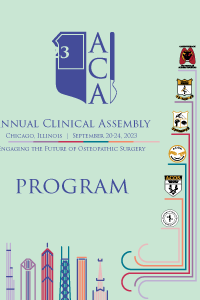ACOS 2023 Annual Clinical Assembly
General Surgery
Outcomes of Ghost Ileostomy and Diverting Loop Ileostomy in Colorectal Surgery

Angelina Trovato, DO
Resident physician
Cleveland Clinic South Pointe HospitalDisclosure(s): No financial relationships to disclose
Member Speaker(s)
Learning Objectives:
- To describe how a ghost ileostomy is created
- To identify complications associated with a ghost ileostomy compared to a diverting loop ileostomy
- To recognize when a ghost ileostomy may be beneficial for colorectal surgery patients
“Ghost ileostomy” is a procedure in which a portion of the ileum is attached to the anterior abdominal wall using a vessel loop. The purpose is to provide the surgeon easy access in creating a diverting loop ileostomy in the event of anastomotic leak. The technique has been utilized in colorectal surgeries in which patients are at medium to high risk for anastomotic leak. If the patient does not develop an anastomotic leak, the vessel loop can be safely removed and the loop of ileum returns to the proper anatomical position. The benefit of the procedure would be to avoid the morbidity associated with creating a diverting loop ileostomy which include parastomal hernias, electrolyte imbalance, dehydration and issues with ostomy hygiene.
Methods or Case Description:
The study was a retrospective chart review of all ghost ileostomies performed in the Cleveland Clinic hospital system from 2012-2022. Patients were risk stratified on their likelihood of anastomotic leak based on the “colon leakage score” (Dekker et. al). This score was then utilized to perform a case match analysis comparing all the patients who received a ghost ileostomy to patients who underwent colorectal surgery with diverting loop ileostomy from 2009 to 2017 in the Cleveland Clinic hospital system. Primary outcomes measured included hospital length of stay, complications (specific to each surgery), hospital readmissions within one year, and mortality rates.
Outcomes:
There were 25 patients in the ghost ileostomy group and 157 patients in the diverting loop ileostomy group. 25 of these patients were matched to the ghost ileostomy group based on the calculated “colon leakage score”. Ghost ileostomy patients had a significantly lower total length of hospital stay (8.54 days) than the diverting loop ileostomy group (14.33 days). The number of patients with complications was significantly lower for ghost ileostomies than diverting loop ileostomies (p=0.005). Additionally, the number of patients requiring a hospital admission was significantly less in the ghost ileostomy group than the diverting loop ileostomy group (p=0.032).
Conclusion: Performing a ghost ileostomy is a safe and viable option for patients undergoing colorectal surgery. It benefits patients by preventing the complications associated with diverting loop ileostomy. Further data is needed to determine the exact indication for performing the procedure.

